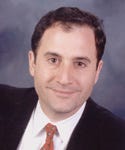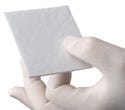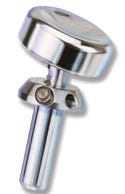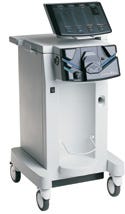Once a small firm with an underappreciated technology, Integra LifeSciences Corp. has become the market leader in neurosurgery and a darling of Wall Street.
November 1, 2007
MANUFACTURERS OF THE YEAR
|
“If you pay attention to the clinical value, you can't help but get the market leadership.”— Stuart Essig, president, CEO |
Many device companies come up with technological innovations that can only be described as amazing. But few are able to translate those breakthroughs into successful products. Fewer still are able to parlay a hit product or two into a successful business.
Integra LifeSciences Corp. (Plainsboro, NJ), a pioneer in tissue engineering, is one of the few that has done all that. It took a while for the firm to find a niche for its regenerative technologies, and then it took a while for its executives to build a fast-growing, sustainable business that went beyond regenerative medicine.
But today, Integra is reaping the benefits of that vision and persistence. Once devoted almost entirely to neurosurgery, it is now a diversified company with worldwide operations. Once struggling to find a significant market for its initial transformative technology, it posted revenues in 2006 of $419 million, up 50% from the previous year, and has maintained that growth through 2007. Once underappreciated by would-be investors, the firm increased its adjusted earnings per share by 30% in 2006 and now has a market capitalization of more than $1 billion.
Add in its unique approaches to research and business development, and its spotless quality and regulatory record, and it is no surprise that Integra has been named one of MD&DI's Manufacturers of the Year for 2007.
An Unthinkable Concept
Like most medical device companies, Integra started with a great idea and not a whole lot of infrastructure. Its story begins with founder and chairman Richard Caruso, who was a venture capitalist with LFC Financial Corp. In 1989, he was inspired by a proposal that his firm didn't think was worth funding. It had to do with the then-far-out idea of enabling the body to regenerate its own parts. He was so convinced of this vision that he left LFC and took the scientists behind the proposal with him.
|
Integra developed a smart valve used to help treat hydrocephalus. |
A firm called Marion Laboratories had started to develop a skin-regeneration technology and had acquired a firm called Collatec, which provided the raw materials for the project. But the endeavor couldn't get off the ground, and Marion Laboratories abandoned the idea when it was acquired by Dow Chemical in the late 1980s. Caruso used his own funds to buy the Collatec business, one of its facilities, and the rights to the skin technology for a bargain price, and Integra was born.1
Integra spent the next few years trying to develop an artificial skin product made from collagen matrices derived from cow tendons. These matrices form a scaffold and the body's cells penetrate it without forming scar tissue. The cells grow over the structure, which is eventually absorbed into the body.
This was not a concept easily understood by Wall Street or the venture capital community. Therefore, during this period, Integra obtained funding from larger medical companies, including Alcon Laboratories and Boston Scientific. By 1996, Integra Skin was almost ready, but the firm did not have the funds to commercialize it. Caruso decided to take the company public in an unusual way. He engineered a buyout of a publicly traded wound-care firm, Telios Pharmaceuticals, which had gone bankrupt. Because of that deal, the firm was able to raise $30 million through the public markets. Less than a year later, Integra Skin not only received FDA approval, but was also honored by the agency as the year's most innovative new technology.
Shortly thereafter, the product's profile got a boost when it was used on Betty Shabazz, the widow of Malcolm X, who was burned on 80% of her body. (At the time this author worked for a newspaper in New Jersey and was one of many journalists to cover that story.) Shabazz passed away, but not because of any issues with Integra Skin. Eventually it was used in the majority of U.S. burn centers.
But its market wasn't large enough for Integra Skin to be a blockbuster, meaning the product wasn't successful enough to be the basis of a business. And so, starting in 1998, Integra changed its strategy.
Building a Business
Integra Skin was originally only approved to be used on third-degree burns. Those kinds of patients needed the treatment over a long period of time, and many of them did not have enough insurance coverage for it. So the market opportunity turned out to be much less than the company expected. (Two other start-ups that developed artificial skin products around the same time as Integra are now out of business.) Caruso knew that the business would have to be grown another way.
To do that, Caruso decided he needed to bring in someone from Wall Street. In 1998, he hired Stuart Essig, who had run the medical technology investment banking division at Goldman Sachs, as president and CEO. Essig was one of the few Wall Streeters at the time who understood the value of what Integra was doing, and he jumped at the chance to take the helm at the firm. “The core tissue engineering technology had tremendous potential,” says Essig. “The challenge for the company was that the cost of bringing it to market in so many different potential therapeutic areas was beyond our means. The singular focus on burns and reconstructive surgery was very limiting. We had not identified a market niche that was profitable. We had to identify new markets.”
During this effort, the new management team found that neurosurgeons were “a really underserved clinical group,” says Essig. “They had some real clinical needs but no company had stepped up to develop and market more products to serve them. So we identified a number of ways to be that company, and that turned Integra around.”
At this time, management made two crucial decisions. One was to find new applications for Integra Skin and to use the platform technology as a basis for other regenerative-medicine products. Integra Skin's sales have quadrupled over the last 10 years, but the broadening of the platform proved even more significant. “We decided to diversify the clinical targets of our core regenerative-medicine technology,” explains Essig. “We wanted to open up neurosurgery, orthopedics, and reconstructive surgery as appropriate applications for tissue engineering. So we focused research, development, clinical, and regulatory resources on those target markets.”
The second was to open up new sales and marketing channels, often through acquisition. “We recognized that we could not build up a sales and marketing organization at a speed acceptable to us and at a cost that would be acceptable to our shareholders,” says Essig. So the firm acquired companies and entered into distribution agreements. It used the fruits of those deals to build an unconventional sales structure. (There have been about 30 acquisitions since Essig came aboard.)
These deals left Integra with a bunch of products that didn't appear to have much in common on the surface. They ranged from the most complex tissue-engineering offerings to the simplest surgical tools. But they did share a very important trait: They were all targeted at the neurosurgeon. And many of the brands acquired were ones these surgeons were already familiar with.
|
DuraGen handles and conforms similarly to normal soft tissue. |
“That meant we were able to bring things like DuraGen [Dural Graft Matrix], which they had never seen before, to neurosurgeons. But we did it on the back of well-established brands that they already knew, and with salespeople they already knew,” explains Essig. “And if you send someone in with a wide array of products, they're going to be more effective than if you only give them one product to sell. They will almost always come away with a sale because of the breadth of our product line.”
“Stuart has a knack for knowing what pieces he needs, and knowing how to fill the gaps in product lines,” says Island Heights, NJ–based consultant Barry Constantine, who was director of product development at Integra until 1999. “And he has the charismatic leadership to hold it all together.”
“One of the things that set us apart is that we adopted a clinical focus as a company, rather than a technical focus,” Essig adds. “The axis of our acquisition strategy was asking: ‘What do neurosurgeons need in their everyday practice that we can produce in a way that is safer and easier to use?' With that focus, we were able to expand our product offerings, with the neurosurgeons as the center of our universe, and with our sales and clinical people looking at ways to add value to their practices.”
That required more than just a strong sales pitch. “What we are trying to do is become the thought leader and help drive the decisions about what they need,” Essig says. “And to be attuned to that when we go to do development. If you pay that much attention to the clinical value, you can't help but get the market leadership.”
After seven years, Integra indeed became the market leader in neurosurgery. Now, using the same model, the firm has begun to go after the hand/foot/ankle sector of the orthopedics market. Essig says the firm hopes it can achieve the same level of success there in 3–4 years. It might be able to do so if the company can become a one-stop shop for everything a hand, foot, or ankle surgeon needs, in the way that it has become such a resource for neurosurgeons.
A Culture of Science and Quality
|
The Integra Mobius system stores data that can be examined with off-the-shelf data analysis software packages. |
Acquisitions have played a key role in driving up Integra's revenues, but so has research and development. Essig says R&D spending “substantially” increases every year and has grown about 400% over the last 10 years. But more importantly, an unusual mix of talents has allowed the firm's researchers to flourish.
“We have molecular biologists and mechanical engineers under the same roof, and you don't see that every day,” Essig says. “You get a lot of unconventional thinking from that kind of diversity.”
This has come in handy not only for the regenerative-medicine offerings, but for other sectors in which Integra plays. Areas of innovation include dural grafts, engineered wound dressings, small-bone and joint implants, bone-regeneration and tissue-guided-regeneration implants, ultrasonic surgery systems, cranial stabilization systems, and brain retraction systems. This diversity should become even wider when Integra completes its acquisition of IsoTis, an orthobiologics company that represents Integra's first regenerative-medicine acquisition in years.
Another way the firm showed its commitment to research was by creating the Integra Foundation in 2002. Since its conception, it has given more than $2 million in grants for healthcare research and education in the areas of neurosurgery, reconstructive surgery, and general surgery. “We fund everything from clinical education to university education to support for crises and disasters,” Essig says.
“For a small company, we have an enormous amount of clinical and regulatory focus,” says Essig. “We have had more than 25 premarket approval applications and PMA supplements approved, and more than 500 510(k) clearances.” Integra's quality and regulatory record is one to envy. The firm has never had a submission turned down by FDA, nor has the agency ever taken any enforcement action against it.
|
Among the company's offerings are products for upper extremity reconstruction. |
“The management seems to embrace quality and be very supportive of their personnel,” says Nancy Singer, president of Compliance-Alliance LLC (Arlington, VA). “Judi O'Grady, senior vice president, regulatory affairs, quality assurance, and clinical affairs, is a great leader and is well-respected within the industry. Her interest in having safer and more-effective medical devices is evidenced by her dedicating time to sharing lessons learned when she speaks at educational seminars. Additionally, she contributes her talents and creativity when she serves on industry policy committees.”
The commitment to quality is something that pervades the entire organization and is at the core of the company's philosophy. “We have a vision statement that is followed at every one of our 20 plants and by all of our sales organizations, and at its heart is this: Just assume that the product you are working on or selling is going to be used on your child,” says Essig. “If you treat something with that level of care and respect, you will have a caring and careful organization. It starts with the culture. We are very aggressive in training, auditing, and making sure we have Six Sigma programs in place. In general, if you do the right things early, you will do better than if you don't respond until after some crisis has developed. We won't bury a quality problem. We don't want to take the risk of being associated with products that fail.” This is especially important at Integra, he notes, because the firm does most of its manufacturing in-house.
How is it possible to maintain this record, given that the company makes several acquisitions each year and must make sure the new subsidiaries get with the program?
“Before an acquisition, we do extensive quality audits with our own people and with outside consultants,” says Essig. “After we complete an acquisition, every site gets a management action plan and is audited subsequently to be sure it is living up to our quality standards.” Many device companies ignore the adage “don't buy a quality problem,” but Integra seems to follow it rigorously.
It also speaks to a strong culture that management still refers to Integra as a small company, even though it is on pace to exceed $500 million in revenues in 2007. “We are a big little company, or a little big company,” says Essig. Much of the attitude and atmosphere present in a large device company—or even many medium-sized ones—is absent at Integra.
“People who join the company are always very surprised that we don't have a ‘not invented here' approach, but a ‘learn from the acquired company' approach,” says Essig. “We are open to putting people from companies we acquire into leadership positions. We often adopt their sales and marketing approaches. We embrace the business opportunities they present. It's a very inclusive approach to management.”
|
Integra's ultrasonic surgical aspirator has helped the firm corner the neurosurgery market. |
There have been some changes as the firm has grown. It adopted a divisional management structure to better respond to customers and competitors. “We wanted to grow to be a $1 billion company, and with that move we didn't feel constrained by our management structure any longer,” says Essig.
Given how far Integra has come since its founding, it is no surprise that in 2006, Ernst & Young named Caruso its Entrepreneur of the Year.
Conclusion
Given Integra's success in the past 10 years, there isn't much reason to change its approach for the next decade. “Our strategy of being a market leader in niche markets is a sustainable one,” says Essig. “Our objective is to be a relatively big firm in smaller fields, where innovation and market leadership matters but 1000-person sales organizations aren't required.”
The IsoTis acquisition could give Integra an entry into the fast-growing spine surgery market, and other areas of orthopedics will also become a focus. “We are launching a mosaic of regenerative-medicine products used in bone reconstruction.” Another market that Integra management thinks is underserved is that of ear, nose, and throat surgery.
Wall Street is similarly optimistic. Glenn Novarro, an analyst at Banc of America Securities (New York City), wrote in a recent research report that Integra's growth outlook is a positive one that should “yield stronger organic sales and [earnings per share] growth, led by [the] extremities and spine businesses. If our thesis proves correct, and we are confident that it will, we see Integra as a sustainable 20%-plus [earnings per share] growth company over the next three years.” He wrote that he is particularly encouraged that Integra is marketing a spine scaffold, Integra Mozaik, not only to spine surgeons but to neurosurgeons that perform spine procedures. And he wrote that the IsoTis acquisition will be a great boon to the spine business.
Wherever the next 10 years take Integra, the company does not want to lose its distinctive culture or business model. “We built an exciting innovation into a financially stable company,” says Essig. “Since we've come that far, I think we have great potential as an organization in the future.”
Erik Swain is editor-in-chief of MD&DI.
Reference
1. Michele Alperin, “Integra Regenerates Itself,” U.S. 1, June 24, 2007.
Copyright ©2007 Medical Device & Diagnostic Industry
About the Author(s)
You May Also Like








